
Understanding dropshipping and steps to launch your own online business

It does not make sense to advertise to people who are not interested in your product. Because of this, it is appropriate to learn how to conduct audience research for your social media ads.
I wasted money when I started doing social media ads—I did not know what I was doing. My experience taught me several principles of advertising, which I will share with you today:
In this article, you will learn:
Audience research is important because you can make more sales if you show your products to people who either need them or want them.
In one forum, Jordan Belfort, one of the greatest salespersons alive today (though not without controversy), said that you should not even bother selling a pen to someone who is not actively looking for a pen.
He said that it is wrong to shove a product down someone’s throat, which is exactly what many first-time advertisers do. And when we push a product to people who do not have an interest in it, these same ad viewers just scroll past through our ads.
Here are some more benefits of choosing the right audience:
You have to find the right audience—those who are interested in your product, to make a sale. Otherwise, you will only waste money in paying for tens of thousands of impressions with little to no click, much less a sale.
We should also think of audience research as using the right bait to attract the right fish. Professional anglers do not use just any kind of bait—they have specific lures that attract a specific kind of fish.
As marketers, this is what we want to do, too. The ad copy is our bait, and we want to use this bait in a certain part of the ocean where that kind of fish lives.
In marketing, we want to show our ad to the right fish—otherwise, we will just end up towing our lure and not catching anything.
To run any ad successfully, you need to create a buyer persona. Think of it as a mascot—someone that represents who your target customers are. While it is easy to say that you want to sell your product to moms or dads, or people looking for phone accessories, marketing runs deeper than this.
In this section, I will show you everything you need to know about creating a buyer persona. The result of this exercise is being able to know who your target audiences are.
A buyer persona is a fictional representation of your target market. You use this persona to guide you in product development, marketing campaigns, and pretty much everything that has something to do with customer-facing activities.
This persona represents your buyer’s behavior, likes, dislikes, work, pain, problems, etc. You can also give this persona a name, and I highly suggest that you do. For example, you can call this persona “Jane.”
You do not need to limit yourself to only one person, as you may have several products that cater to different audiences.
Once you have this persona available, a big chunk of your business decisions will involve this persona. You will ask yourself questions like:
As you can see, everything about your marketing strategies and audience selection becomes easier once you have created a persona.
Here is a summary of a buyer persona’s benefits:
With a mascot or buyer persona, you now have the opportunity to tailor-fit your ads and product selection to a specific audience. You will no longer second-guess if your decision is right or wrong.
You need to get into the mindset of this person. You need to understand her, her situation in life, the things she is dealing with, her fears, joys, etc.
Now, let us look at the factors that you must use to create the buyer persona. Keep in mind that what we are trying to accomplish here is to create a fictional character—one who represents our target buyer.
We need to start with the demographics—this, of course, depends on the type of product that you are trying to sell. In this example, we will use formal clothing as a product.
Here are some starting details:
We now have a basic structure for our target buyer. What we need to do next is to get deeper. We want to figure out Jane’s psychographics and behavior.
Since Jane is a professional, we can expect her to go to sites like LinkedIn, as it is important for her career. As an active person in the corporate world, it is not unlikely that she is on Facebook. At her age and with the kind of work she does, we can say that she is not likely to use apps like Snapchat or TikTok.
Since Jane is also a mother, it is possible that she also uses Pinterest, an app whose primary demographic is mothers. We can also say that she must be an Instagram user. After all, she wants to see other executives check out their suits.
Jane is a corporate executive, and we can say that she has goals, one of which could be sales, talent acquisition, etc.
Here are some more we can add to her goals:
As a woman and a corporate executive, Jane probably likes to eat out, have dinner with friends, or go to the gym. She is also likely a member of a club—could be a wine club if she is in California. As a mother, she may be interested in cooking.
Now, we have a clearer picture of who our target market is. From this persona, we can start building an ad that revolves around our Jane. The ad copy must target Jane’s fears and goals.
From here, we can use images of a formal wearing formal corporate attire. Then, we spice things up with slogans, such as:
More importantly, we can now run our ads and show them to the right people. In this case, we will run the ads on:
In addition, we will show our ads to women only, 25 to 50, and only in California. In the interest field, we will add the following things:
From here, we can say that our ad will show to the very person we are targeting, as opposed to showing it to random people.
Do not expect the ad platform to religiously follow your ad requirements. There will still be impressions that will slip through the cracks. For example, Facebook will still show your ad to some men, or people above or below your target age range or demographic.
What do we get from all of this? For one, we do not waste our money showing our ads to people who are not likely to be interested in our ads. Second, we can expect the ad viewers to respond positively, such as by clicking our ad, going to our online store, and making a purchase.
Audience research does not mean merely choosing where to show your ads. When I was just starting to use Facebook for my marketing efforts, I did not know that I could go deeper in my audience selection, and it was a mistake that cost me money.
Essentially, there are three aspects that you must consider in audience research. These are demographic, psychographic, and behavioral aspects.
Demographics refers to a type of statistical categorization of the characteristics of a population. These characteristics are based on demographic factors, like race, gender, religion, educational attainment, and many more.
Here are some of the most common examples of characteristics of an audience:
Why is this important? Certainly, you do not want to sell women’s products to men. For example, it is unwise to advertise high-heeled shoes to men because men are not the primary users of this product.
In another case, it is not advisable to advertise kids’ toys to people between the ages of 18 and 21—it is very likely that these people do not have children. While it is true that they may have nephews and nieces, it is rather a rare occurrence and not an expectation.
For a product such as a toy, it is best that you advertise to people in their late 20s to early 40s. These are the people you want to see your toys—they either have kids or are financially capable of buying toys for kids they know.
In addition, you can use demographics in building your target audience profile or persona. Without demographics, you cannot possibly envision the kind of audience you are looking for.
The psychographic aspect of audience research refers to how your target customers think. What you want to find out here is a deeper understanding of what your customers need, want, or the pain that they want to go away.
Here are some examples:
As you can see by now, you can mix and match both demographics and psychographics to be able to conduct your audience research.
For example, you can consider the following demographic information:
From here, you can target who your audience is. For example, you can now advertise on Facebook and only show your ads to people who meet these conditions.
I am not saying that all these options are available on advertising platforms. Facebook, for one, does not have an option you show ads based on revenue or salary bracket. However, you can advertise to people who live in New York City only, females, etc.
Another thing I want to point out here is the fear, need, and pain factors. Every person has something that he needs or wants.
For example, parents want their children to develop mentally. Education and development are both problems and as such, you can provide them with a solution. In this case, you can sell educational toys to them—it solves the problem of educational development.
This one refers to how people behave in so many ways. Below are some examples:
Out of these three aspects of customer data, the behavioral one is the most difficult to pinpoint. On some advertising channels, you can find behavioral data like the time your ad gets the most clicks.
In most cases, you will have to gather this data and conduct market research yourself, and you can only do so if you collect data after you advertise, not before you advertise. You can do what we call in the advertising world the A/B test. In this method, you will advertise the same product, but you will target different audiences.
From here, you can determine which audience has a better response to your ad. For example, you can target people interested in Kim Kardashian, and the other ad will target people interested in Khloe Kardashian—and your product is a lipstick.
Once you are done running the ads, you can compare the results of clicks, conversions, impressions, etc. From here, you can see either a big or small difference. If you have a higher click-through rate for the Kim audience, then it just tells you that as far as behavior is concerned, those who love Kim are more responsive to lipsticks than those who follow Khloe.
Behavioral analysis is a bit expensive. Is it a necessary thing to do in advertising? Yes, it is. However, you do not need to run multiple A/B testing right away.
If you are new to advertising, social media analytics and marketing, I suggest that you start with the first two aspects but keep data and reports that you can use for behavioral comparison later on.
Tradelle is more than just a platform where you can find winning products to dropship. You can also use Tradelle to find the right audiences for the products that are recommended. In this section, I will show you how to use the platform for audience and market research purposes.
The first thing to do is look for a product that you are interested in selling. Below is an example.
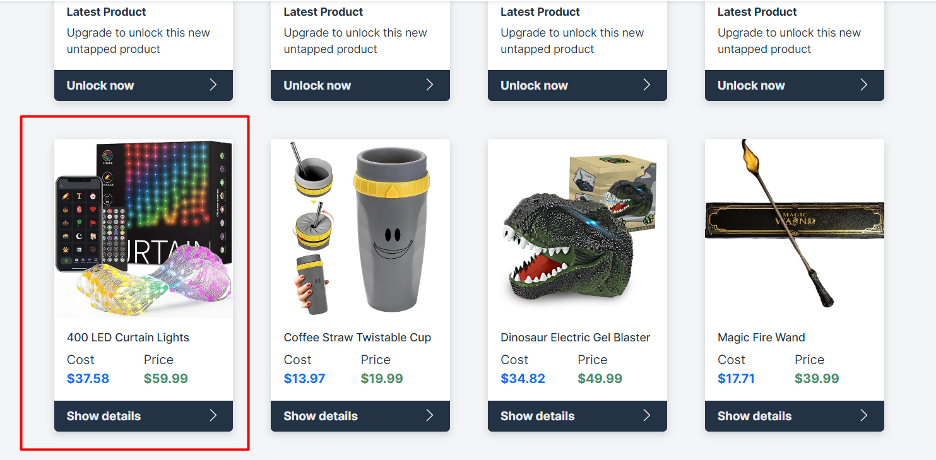
You either do this by searching for a product with keywords, navigating the Product Picks section, or combing through the product selections in the Current Trends section.
After clicking the product you like, you will see something like this:
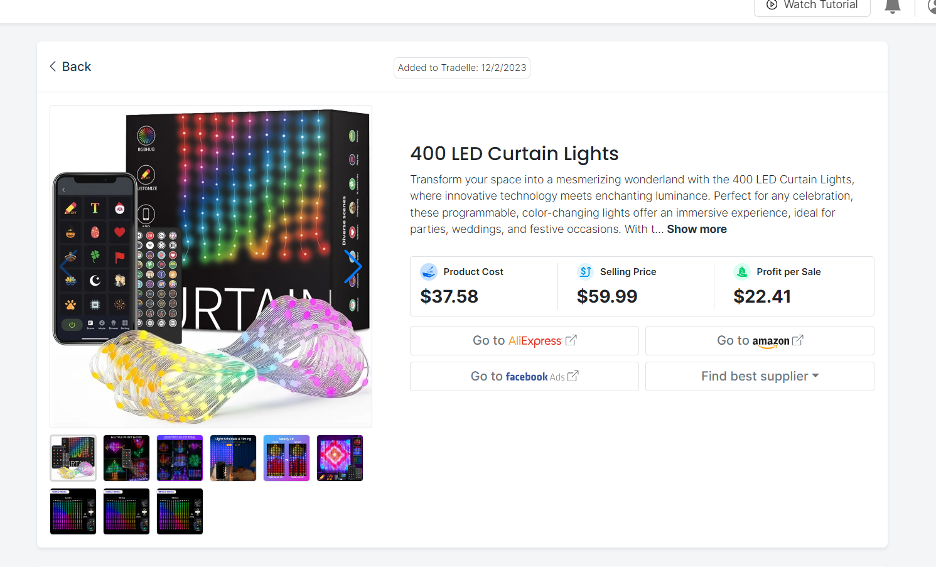
From here, you must scroll down until you find this section:
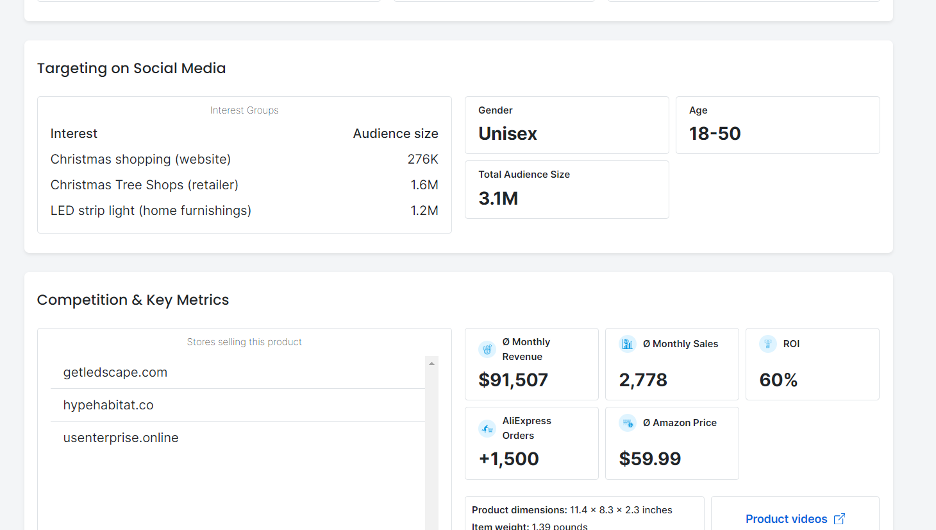
As you can see, the tool provides several interest groups that you can target. In this example, there are three recommendations, and you will see the audience size for each interest group.
You will also see the gender and age demographics for this product. As you can see, it is a unisex product targeting people 18 to 50 years old.
Which audience size should you choose? It is really up to you. You need to play around with your advertising platform. For example, on Facebook, you will get a broader audience if you select more interest groups. Keep in mind that you must also choose the location of your target market.
Take a look at this example:
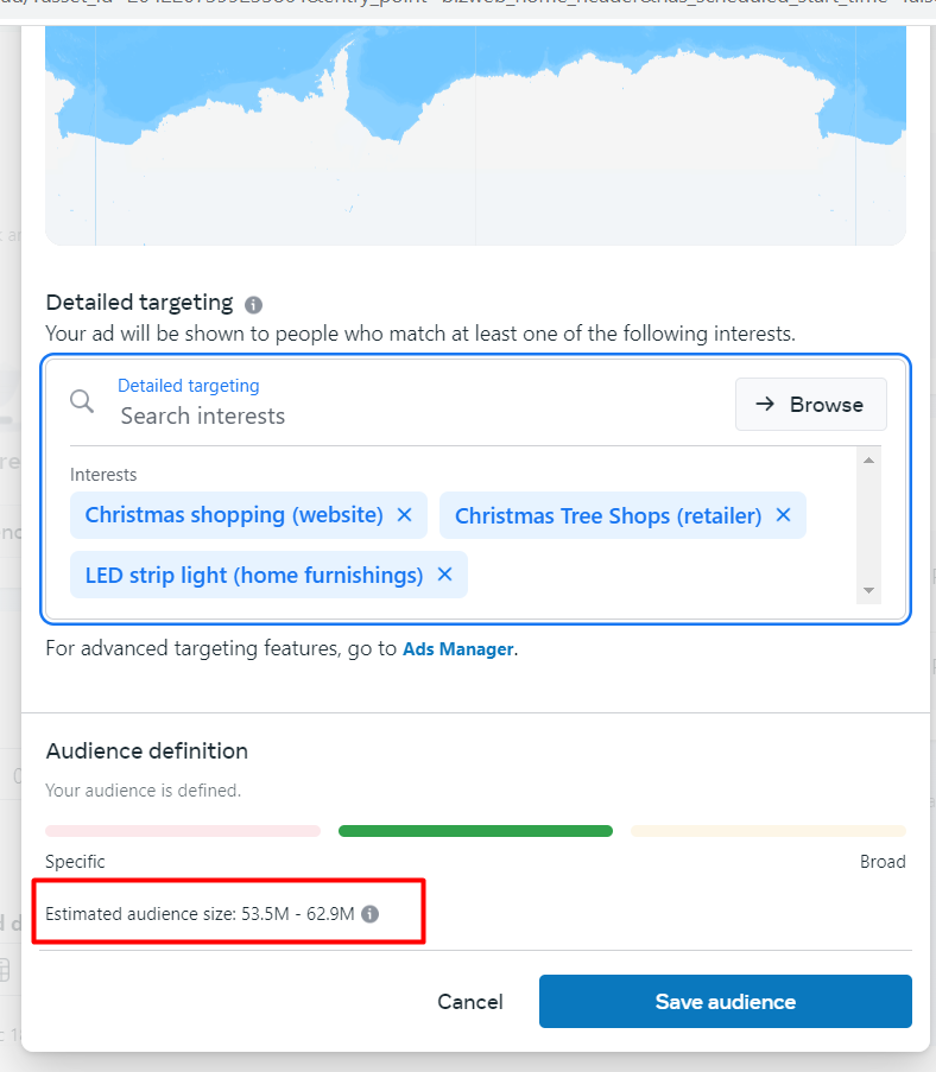
The image above is a screenshot of an audience that I am building on Facebook. The target demographics are:
Then, I used the three interests to narrow the target market. As you can see, the audience is defined, and we have a green mark or line under the Audience Definition section. At the bottom, we can see that Facebook can show this ad to many people, between 53 million and 62 million.
If I remove two interests, this is what I get:
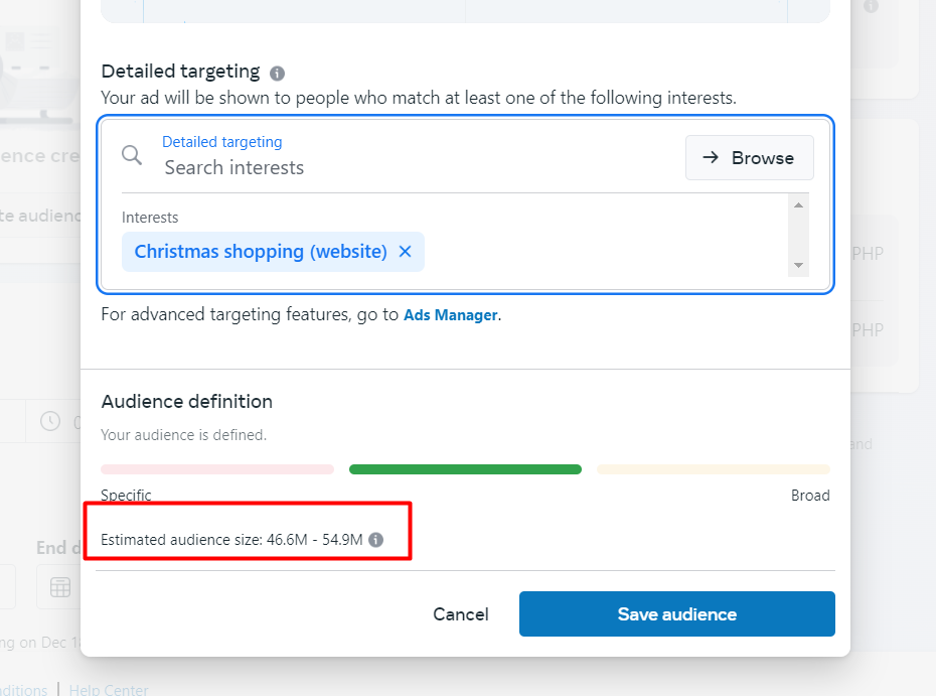
The audience size now is between 46 million and 54 million. So, should you include all the recommended interests or not?
The answer depends on your budget. The bigger your audience is, the more impressions Facebook will make for your ad. As you know, the more impressions there are, the higher your advertising costs will be.
For as long as the marker is green, the audience selection is good. If it is red or orange, you should either add or reduce your audience demographics and interests.
As far as the budget goes, you can set a definite amount per day during the ad creation process on Facebook. The system will tell you if your budget is too low.
The beauty of advertising on Facebook is that the system will tell you an optimal budget to make your ad competitive. What this means is if your budget is too low, you cannot even go ahead and run your ad.
Now, if you scroll down further, you will see these details:
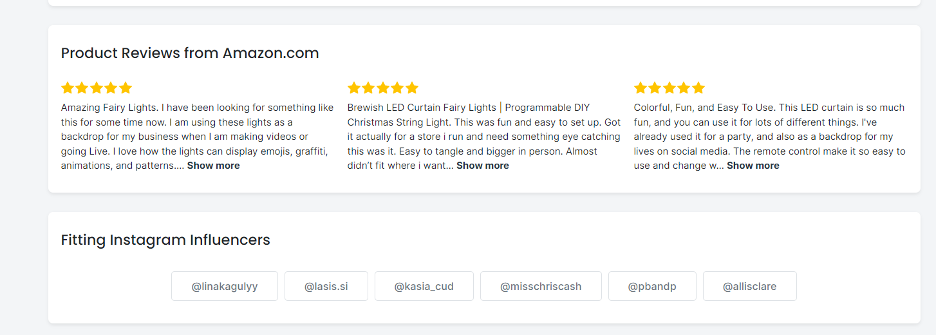
As you can see, the customer reviews from Amazon can give you an idea of how to run your ad copy. These comments also tell you the psychographic and behavioral aspects of the right target audience or market for this product.
For example, the first comment said, “Use this backdrop for my business.” From here, we can say that business entities and managers are interested these lights.
Finally, you can view some Instagram influencers at the bottom. Check out their channels and see what kind of niches they support. If you want, you can even make a deal with these influencers.
The next step that I highly recommend is to sign up for a free account with Tradelle. You will have access to winning products and their respective, target markets and audiences. Or, you can start building your buyer persona for your products if you have them already. This can take a while, but I assure you that it is all worth it.


Understanding dropshipping and steps to launch your own online business

Discover top strategies to identify high-demand, profitable products on AliExpress

Learn about strategies that drive traffic to your store, including effective advertising practices

Learn about several proven methods to increase your store sales
Imagine someone asks you who your supplier is, and then you have to tell them it’s a private agent, or AliExpress, or an automation tool that simply buys from AliExpress for you. It’s 2025. Your customers, your revenues, and your profits will thank you.
Get started for free